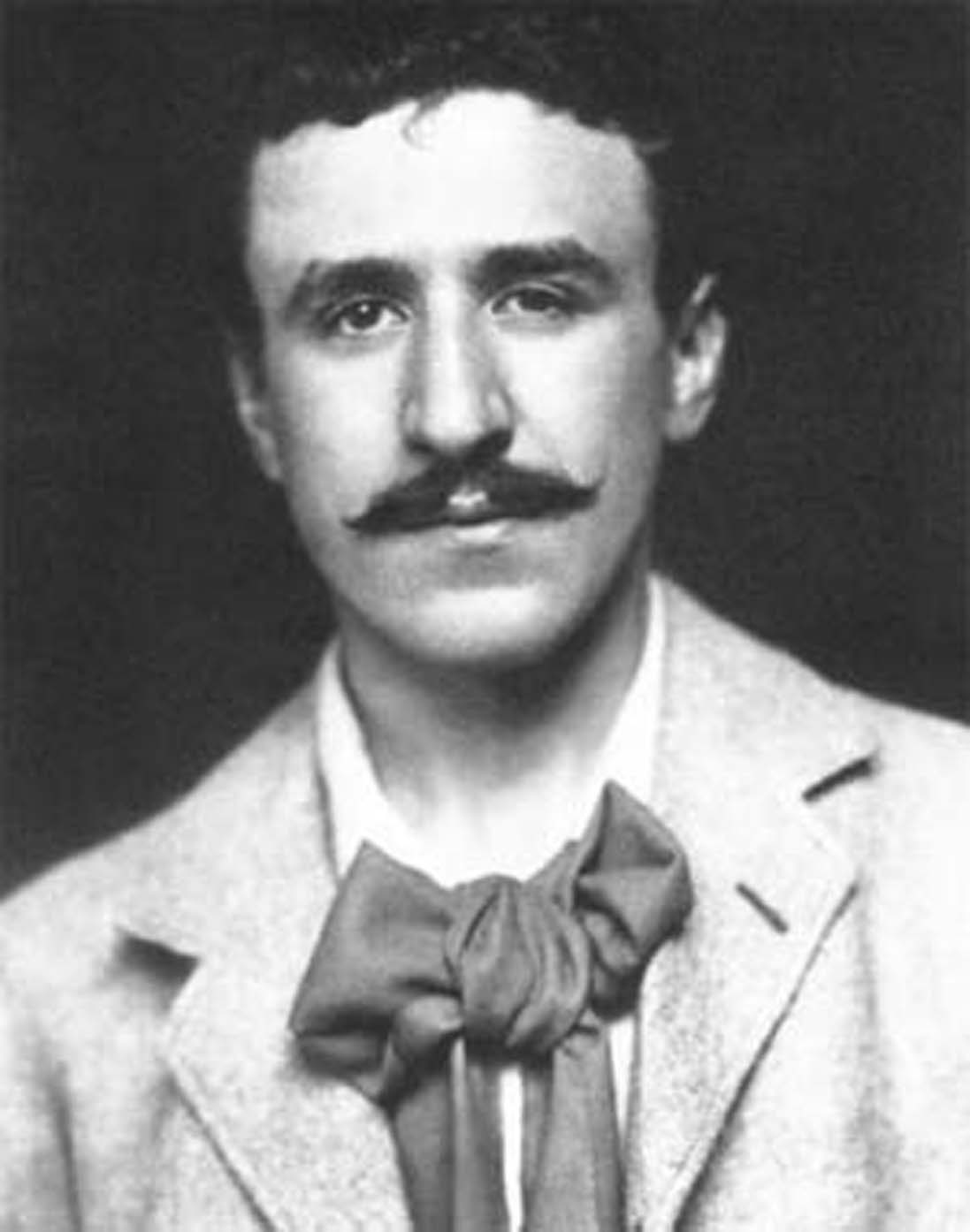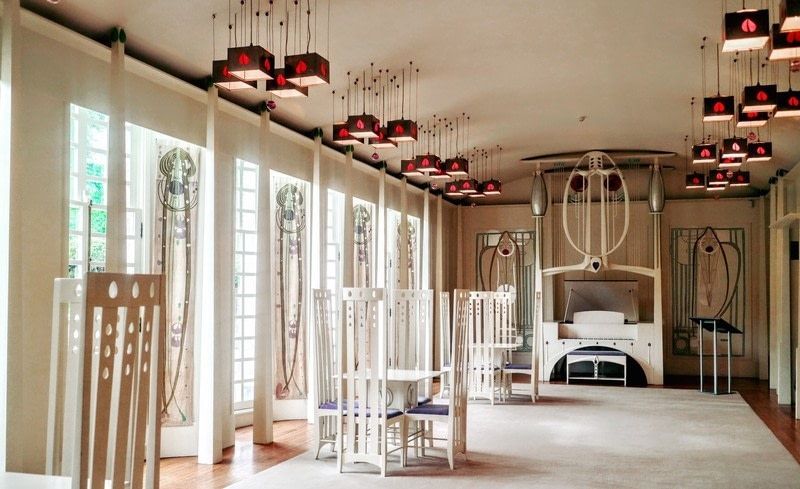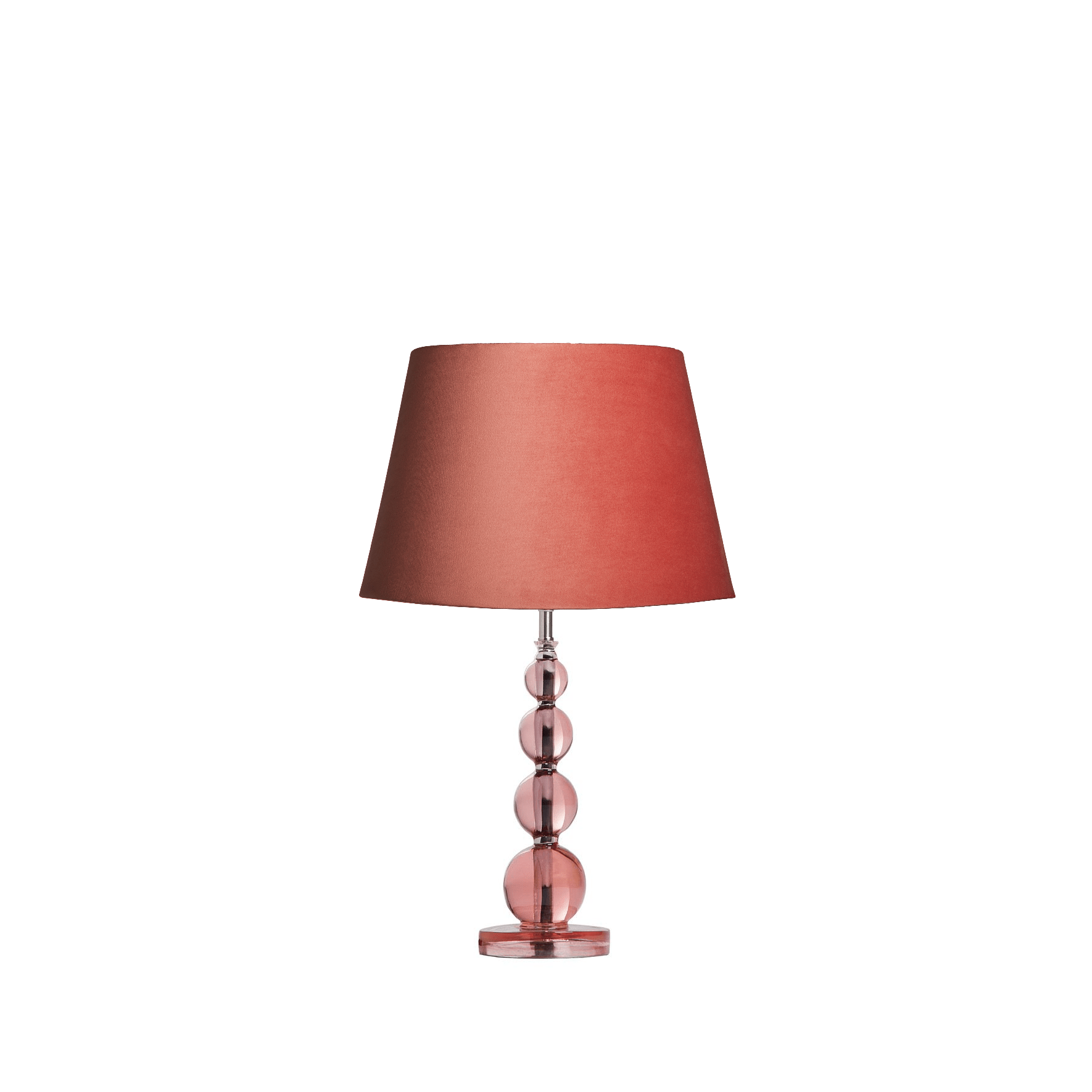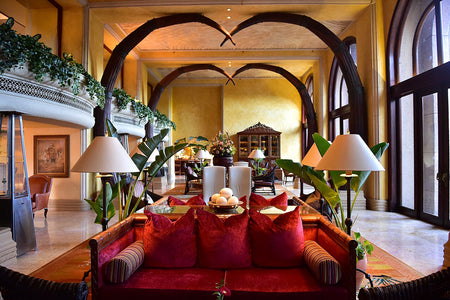
All about the great Scottish architect, artist and interior designer Charles Rennie Mackintosh – plus Pooky’s tips on how you can bring you his aesthetic into your home decor (with the accent, naturally, on lighting)...
His work was and, almost a century after his death, remains instantly recognisable. The Glasgow-born architect, interior designer, furniture designer, and artist Charles Rennie Mackintosh was revered throughout Europe but struggled for recognition in his home city. This was despite the imposing presence of the Mackintosh Building for the Glasgow School of Art, completed in 1909, which attracted worldwide acclaim. Mackintosh was responsible not only for the exteriors but for the interior design and furniture too, down to the smallest details, including door knobs and window latches.
In 2009, readers of the Sunday Times and the RIBA Journal chose it as their favourite British building of the past 175 years.


Facade detail, the Glasgow School of Art
So, it seems fitting for our new series looking at the work of great interior designers to start with Mackintosh. But he would have been the first to insist that the work of his wife, Margaret Macdonald Mackintosh, should be given due recognition too. Margaret was a gifted artist, metalworker, embroiderer and textile designer and, between 1895 and 1924, contributed to more than 40 exhibitions throughout Europe and America, and was always closely involved in her husband’s architectural and design projects.
‘Margaret, ‘ said Charles Rennie Mackintosh, ‘has genius; I have only talent.’

Margaret Macdonald Mackintosh
From influenced to influencer
Charles Rennie Mackintosh was born in Townhead, Glasgow in 1868, the fourth of 11 children. At 18, he won a travelling scholarship to study classical architecture and was subsequently apprenticed to a Glasgow architectural practice – then the traditional route into the profession – while studying at the Glasgow School of Art. Here, he and fellow architectural apprentice Herbert MacNair, met the Macdonald sisters, Margaret and Frances; they became known as ‘The Four’ and were prominent figures in Glasgow Style art and design.
While drawing on the Scottish design heritage, Mackintosh was deeply influenced by the simplicity of Japanese design, with its emphasis on natural materials, texture and light. Modernism was in the ether too, and another significant influence, but Mackintosh found some aspects of the movement, with its severe lines and lack of ornamentation, too harsh; he preferred the softer flourishes and curves of Art Nouveau. All these influences found expression in Mackintosh’s distinctive combination of squares, right angles, floral and decorative motifs and curves.
Bedroom, Hill House, Helensburgh - Image: National Trust Scotland
Mackintosh insisted on total control of his architectural projects and commissions, so his designs also included specifications for decoration, furniture and furnishings, down to the smallest details, such door handles and window fittings. And it was usually Margaret who was responsible for the detail… While some clients were willing to let Mackintosh manage things his way, his insistence on complete control did not always sit comfortably with others.
Mackintosh’s architectural ironmongery, Glasgow School of Art
Spanning just a decade from 1895-1906, Mackintosh’s architectural career was relatively short but his work had an impact far beyond Scotland, particularly across Europe. Josef Hoffmann, for example, one of the founders of the Vienna Secession, was one of Mackintosh’s greatest admirers.
In 1902, the Mackintoshes’ innovative designs for an art lover’s house, their entry for a competition run by a German magazine, attracted widespread praise, but the submission arrived too late to be considered. The House for an Art Lover was eventually built in Bellahouston in 1989 and is now a popular wedding, arts and events venue.
Dining area, House for an Art Lover, Bellahouston. Image credit.
By 1914, Mackintosh had become disillusioned with Glasgow and he and Margaret left their home city, never to return; they settled in Walberswick in Suffolk, where Mackintosh began to spend more time painting with water colours. But, in the heightened tensions of a small coastal town in a country at war, Mackintosh was – bizarrely – suspected of being a German spy and briefly arrested. (For the details, see Mr Mac and Me, Esther Freud’s excellent fictional account of this event.)
Larkspur, Walberswick, 1914 (from a sketchbook). Image credit.
The Mackintoshes moved again in the early 1920s, opting for the warmth and light of Port Vendres in southern France, close to the Spanish border. By this time Charles Rennie Mackintosh had completely abandoned architecture and interior design and spent his time on water colours of local buildings set in their surrounding landscapes.
In 1927, ill health forced the couple to leave France: Mackintosh had been diagnosed with cancer of the tongue and throat. After a brief period of recovery, he was admitted to a London nursing home and died in December 1928; Margaret died less than five years later.

The Summer Palace of the Queens of Aragon, water colour, 1924
The Mackintosh style – where to see it
When the west wing of the Mackintosh building at the Glasgow School of Art was damaged by fire in 2014, who could have predicted that just four years later, another fire would cause far greater damage? The rebuilding work continues.
The Library, Mackintosh Building, Glasgow School of Art, 1897-1909. Photo: Bob Proctor.
Nevertheless, it is possible to visit other Mackintosh buildings (but do check relevant websites for current details). Top of the Mackintosh trail would have to be Hill House at Helensburgh, just outside Glasgow. Designed and built for the Blackie publishing family, it is regarded as Mackintosh’s domestic masterpiece, and deservedly so. (Unfortunately, it has also suffered severe external water damage and is temporarily encased in a weatherproof box, while a 10-year restoration programme is under way.)
The music room, Hill House, Helensburgh, 1902-1904, with Mackintosh design hallmarks. Image credit.
You can feast your eyes on Mackintosh furniture and interiors – and take tea and much more - at Mackintosh at the Willow, a complete restoration in the original Sauchiehall Street building of the stunning interiors he created for Mrs Kate Cranston’s famous Willow Tea Rooms.
Mackintosh at the Willow. Image credit.
Mackintosh designed just one house south of the border – 78 Derngate in Northampton. He adopted a far more geometric look, including squares and chevrons, reflecting the taste and interests of his client, W Basset-Lowke, a model engineer. The block colours are still neutral but darker than those of Hill House and more similar to the Glasgow School of Art interiors.
Hall and stairway, 78 Derngate, Northampton, 1916. Image credit.
A touch of Charles Rennie Mackintosh in your home
Reproductions of Mackintosh’s work has ended up on a plethora of domestic and personal objects, from fleece throws and credit card holders to tote bags, plastic trays and, of course, tea towels, the fate of many great artists and designers. If you are an admirer, you probably won’t want to go down that route...
Pay homage by opting instead for neutral block colours, curves, stained glass and decorative motifs, for example. And, if you long for a piece of his distinctive furniture, such as an Argyle chair, take a look at the Mackintosh range, produced by Glasgow-based, Bruce Hamilton Furniture Makers. The company has produced Mackintosh-designed pieces for the School of Art, House for an Art Lover, and Mackintosh at the Willow.
Mackintosh’s Arygle Chair - the design was based on a swallow in flight. Image: MAAS
Lighting your home the Mackintosh way
Another way of bringing a hint of Mackintosh into your home is with carefully chosen lighting. We’ve put together a special Pooky selection, inspired by some of his most famous projects.The Hill House look


A pink lampshade - perhaps in silk or velvet – would complement those Mackintosh rose motifs perfectly. Here we’ve teamed our antique rose dupion silk shade with a Rose wall fitting in chrome. For a table lamp, how about pairing the Aurora table lamp in blush pink with a posh pink straight empire shade?
A tribute to the Glasgow School of Art

If you were fortunate enough to visit the Glasgow School of Art or study there before the devastating fires, you’ll have seen Mackintosh’s eye-catching metal and glass pendant lights in the library. Of course, you don’t need to have a large library to warrant a pendant light; they’re versatile enough to work well in an entrance hall, a kitchen, or a dining area.
Here at Pooky, you’ll find a range of metal and glass pendant lights and we think our Apollo, with its antiqued copper frame, strikes just the right note.
A house fit for an art lover
Take a lead from the dining room at Bellahouston, and choose a plain glass pendant light, like Pooky’s Bulbus. Even better, go for a line of them! It’s a supreme piece of glasswork, topped with beautiful, buttery brass fittings. It has an almost fluid feel (very Mackintosh, that) and with the right bulb, is a bit of a stunner.
Welcome to Derngate

The precise lines of Pooky’s Orford exterior wall light would not have been out of place outside the Northampton house, with all its geometric features and motifs. Rust proof and waterproof, it’s made from heavyweight solid brass and, once installed, it’ll happily grace your front door for years.
Mackintosh squared

Where to find out more about Charles Rennie Mackintosh
The Charles Rennie Mackintosh Society was set up in 1973 to promote and encourage awareness of his work. It is housed in Queen’s Cross Church, Glasgow, which was completed in 1899 and is the only church designed by Mackintosh. The Hunterian in Glasgow is Scotland’s oldest public museum. It houses one of the world’s most important collections of the work of Charles Rennie Mackintosh and Margaret Macdonald Mackintosh.
Enjoyed this post? You might also like:
Great Interior Design Styles and How to Light them: Art Deco
A History of Design in Table Lamps: Thomas Edison to Art Nouveau











